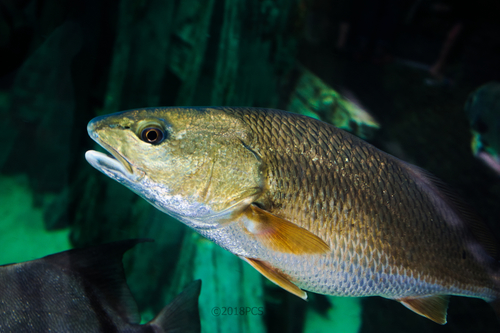
Red Drum
The Atlantic Bluefin Tuna (Thunnus thynnus) is a majestic and powerful fish, renowned for its size, speed, and commercial value. This highly migratory species plays a crucial role in the marine ecosystem and is a top predator in the Atlantic Ocean.
3 40 years
Lifespan
61 - 99 cm
Length
Least Concern
Conservation Status
35 km/h
Swimming speed
Carnivorous
Diet
Local Migration
Migration
Appearance Overview
The Atlantic Bluefin Tuna is renowned for its large, streamlined body, built for speed and endurance.
Color
Dark metallic blue above, shimmering silvery-white below
Body Shape
Torpedo-shaped, designed for efficient swimming
Fins
Two dorsal fins, with the second being taller; small finlets run down the back and belly towards the tail
Scales
Small and smooth, contributing to reduced drag in water
Length
Commonly up to 6.5 feet (2 meters), can reach up to 13 feet (4 meters)
Weight
Typically around 550 lbs (250 kg), can exceed 1,500 lbs (680 kg)
Diet
Carnivorous, feeding on a variety of fish (like mackerel, herring, and hake), squid, and crustaceans.
Feeding Behavior
Opportunistic and highly active predators, bluefin tuna use their speed and agility to hunt. They often feed in coordinated groups, herding prey or ambushing from below.
Social Behavior
Highly migratory, forming large schools, especially during spawning. They exhibit complex social behaviors, often grouping by size rather than age.
Commercial Relevance
Extremely high value, particularly in sushi and sashimi markets, where its fatty flesh is considered a delicacy. This demand drives significant fishing pressure.
Conservation measures
Management includes fishing quotas, size limits, and seasonal closures, enforced by international bodies like ICCAT. Efforts also focus on reducing bycatch and improving fishing gear selectivity.
Status
Currently listed as an endangered species
Threats
Overfishing is the primary threat, driven by high demand for sushi. Other threats include habitat degradation, climate change affecting prey distribution, and bycatch in other fisheries.
Habitat Distribution
Depth Range
Typically found from the surface to depths of 1,600 feet (500 meters), but can dive much deeper, exceeding 3,000 feet (900 meters).
Geographic Range
Widely distributed across the North Atlantic Ocean, including the Mediterranean Sea. Found in both Western and Eastern Atlantic waters.
Preferred Environment
Prefers temperate and subtropical waters; highly migratory, covering vast distances across ocean basins.
Reproduction and Life Cycle
Breeding Habits
Spawns in two main areas: the Mediterranean Sea and the Gulf of Mexico. Spawning typically occurs in warmer waters during specific seasons.
Development Stages
Eggs hatch into larvae, which feed and grow rapidly. Juveniles develop in nutrient-rich waters, gradually gaining the characteristics of adult tuna.
Fecundity
Highly fecund; a single female can release up to 30 million eggs per spawning season, although survival rates to adulthood are low.
Maturity Age
Reaches sexual maturity relatively late, typically between 4-8 years of age, although this can vary by location.
Faqs about Red Drum
Where can you find Atlantic Bluefin Tuna?
Atlantic Bluefin Tuna are found across the Atlantic Ocean, from the cold waters of the North Atlantic to the warmer tropical waters of the Gulf of Mexico and the Mediterranean Sea.
How long do Bluefin Tuna live?
They can live up to 40 years, although many don't reach this age due to fishing pressures.
Are Bluefin Tuna endangered?
Yes, their populations have significantly declined due to overfishing, leading to their endangered status.
What makes Bluefin Tuna unique among fish?
Bluefin tuna are warm-blooded, unlike most fish, which allows them to maintain a higher body temperature than the surrounding water, aiding in their speed and endurance.
How deep can Bluefin Tuna dive?
They can dive to depths of over 3,000 feet (900 meters) in search of food.
What is the biggest threat to Bluefin Tuna?
The main threat is overfishing, driven by demand for their meat in sushi and sashimi.
What do Bluefin Tuna eat?
They primarily eat a variety of fish, squid, and crustaceans, hunting using their speed and agility.
Are there any fishing regulations for Bluefin Tuna?
Yes, there are strict regulations, including quotas and size limits, to try and manage and conserve Bluefin Tuna populations.
When do Bluefin Tuna reach maturity?
They reach maturity at around 4-8 years of age, depending on their location and environmental conditions.
How fast can Bluefin Tuna swim?
Bluefin Tuna can swim at speeds up to 43 mph (70 km/h) when chasing prey.
Copyright @ Nature Style Limited. All Rights Reserved.
 English
English